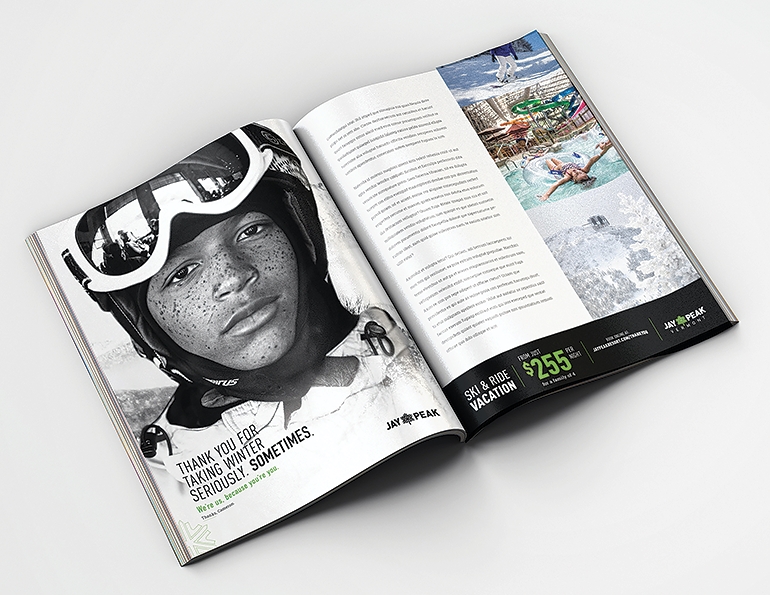Research on advertising suggests that the emotional response to an ad has a much greater influence on consumers’ intentions than the ad’s content itself. It makes sense: emotional connections happen because we’re human—we’re built for these connections, and rely on them to live a rich, meaningful life. Human emotion will always be core to our DNA. Therefore, marketing that appeals to raw and genuine human emotion is essential, and ultimately pays off. This approach is called emotive marketing.
Propelled by this idea, our agency recently launched a campaign for Vermont’s Jay Peak that focused entirely on creating an emotional connection with its guests. (See “Best/Worst Marketing,” Most Respected Marketing Campaign, p. 72, for a review.) We didn’t show photos of the mountain, the waterpark, the lovely hotel rooms, or even action shots of the resort’s famous glade skiing. We chose instead to go beyond basic product marketing and really create a connection with the audience—and it’s working. It’s connecting with new and existing guests and staff by tapping into their emotions, allowing us to educate them, build trust and credibility, and position Jay’s brand as relevant to them.
So, what is emotive marketing? How does it work? And when is it appropriate to incorporate it into your marketing?
What Does “Emotive Marketing” Even Mean?
In short, emotive marketing means moving away from talking about the physical offerings and amenities at your resort and focusing instead on the “when” and “how” you do it. It creates a sense of connection with your guests on an emotional level.
A good way to understand this approach is via the Golden Circle, a concept developed by British author and organizational consultant Simon Sinek. Its framework states that “people don’t buy what you do, they buy why you do it.”
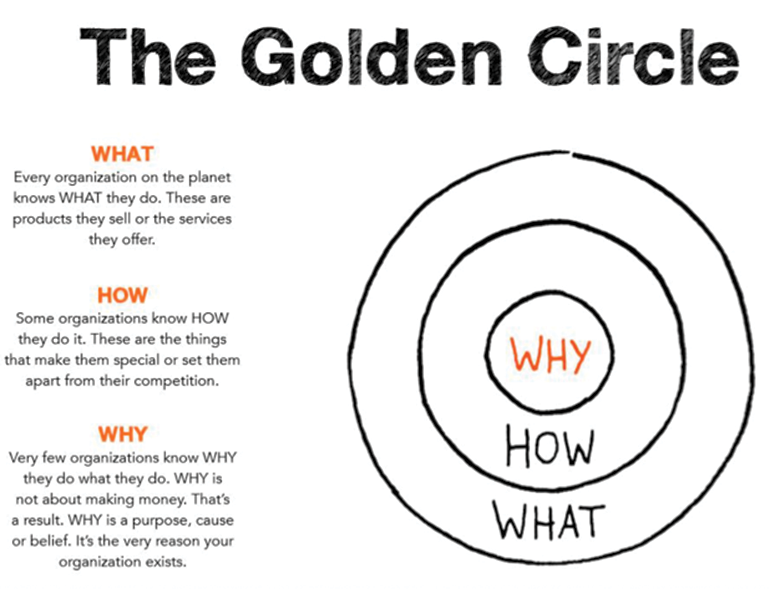
Generally, most brands communicate their value proposition by starting with the “what,” and then eventually work their way back to talking about the “how” and the “why” of what they do. Sinek’s Golden Circle turns this around in an attempt to explain why some brands are particularly successful at inspiring their customers and can position themselves so effectively. The neuroscience behind the Golden Circle framework is that humans respond best when messages tap into and resonate with the parts of their brain that control emotions, behavior, and decision-making.
Practical Applications
Marketing the “what” for a ski resort might look like this: “We have 100 trails, expanded snowmaking capacity, lots of restaurant options, and affordable lodging. Want to book a vacation here?”
Sound familiar? It should, because that’s what 90 percent of ski area marketing sounds like. We, as an industry, perpetually push the “what” we do, which is largely undifferentiating. And while the facts of your ski area are true—you do have lots of trails, great snowmaking, restaurant options, and comfortable beds—telling me these without any emotional appeal is unlikely to move me.
So, what if we flipped the traditional formula on its head and put the “why” front and center? What if you shifted your product attributes to be ancillary to the “why” rather than being the centerpiece of your campaign? This is where we believe lies the sweet spot of ski area marketing.
We didn’t invent this concept. Companies that are universally identified as unique and successful, such as Apple or Google, communicate with this sort of “inside-out” mindset. Starting with the “why,” then moving on to talk about the “how” and “what” has been wildly successful when done correctly.
Why “Why” Matters
So, why does the order in which you communicate your story matter? It has to do with the parts of the brain that we use to communicate. When you’re talking about the “what,” you’re speaking to the analytical and pragmatic part of the brain. However, talking about the “why” and “how” resonates with segments of the brain related to emotion and human behavior—much more powerful things.
Let’s look at some examples of emotive marketing.
Jay Peak: We’re us, because you’re you.
In our latest Jay Peak campaign, we quickly realized that there was a need to stop focusing on snow advantage and vacation planning (the “what”) and go back to the foundation of what makes a ski vacation so appealing (the “why”). We illustrated that choosing to come to Jay says something about one’s character, and that the resort celebrates people for being who they are.
At the same time, it says something positive and sincere about Jay Peak. This insight, that the resort’s character and values are a result of the people that work there and visit there, was at the heart of the campaign concept. We acknowledged that the resort wouldn’t be what it is without the community behind it, and that Jay Peak is defined by its people. Put simply, this campaign is a “thank you” to its dedicated fans and loyal staff.
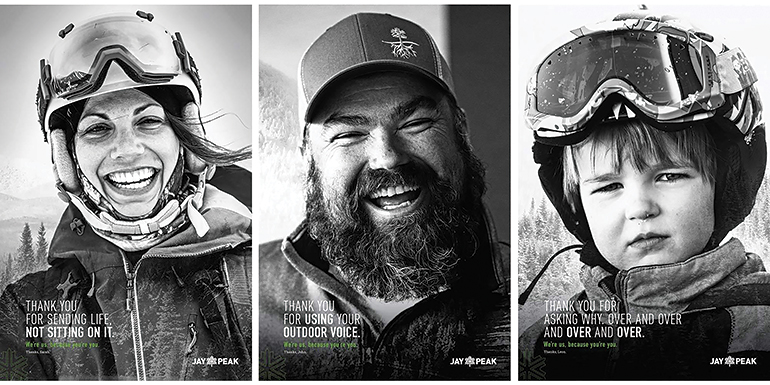 Jay Peak’s campaign aims to create a connection with guests and staff by tapping into their emotions.
Jay Peak’s campaign aims to create a connection with guests and staff by tapping into their emotions.
We decided a campaign capturing the faces of Jay Peak would be the most effective way to talk to the people rather than just about them. The concept is simple: “At Jay Peak, who we are is a product of who our people are: independent, hard-working, and connected by the things we love. For this, we are grateful. For you, we stay true to ourselves. We’re us, because you’re you.”
By using language spoken by guests and staff, demonstrating the character and vibe of the resort through the community, and eliciting a sense of pride in those who choose to make Jay Peak a part of their lives, the campaign makes emotional connections with real people.
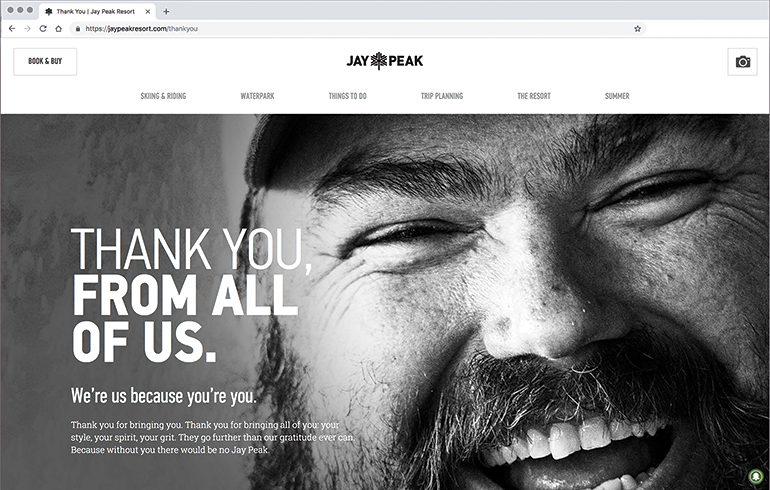 Jay Peak print ad magazine spread.
Jay Peak print ad magazine spread.
Of course, the brand also needed to promote specific tactical offers. In these instances, we removed the “thank you” message and emphasized the unique guest attributes we’re grateful for. We used tactical headlines to capture the feeling of pride conveyed in our brand executions in a way that speaks to Jay’s audience. For example, “Hats off to the powder hounds” promotes skiing products, and “Here’s to webbed toes” headlined waterpark promos.
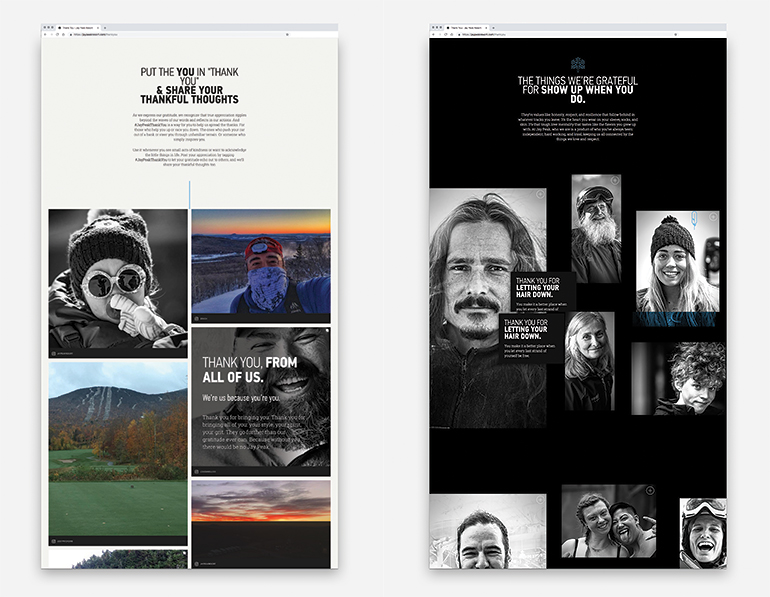 Jay Peak email campaigns invite engagement and educate guests, building trust and credibility.
Jay Peak email campaigns invite engagement and educate guests, building trust and credibility.
We also removed the portrait photography to show actual products or images of ski action. Knowing that there is a place and need for this form of lower-funnel marketing, creating an effective offering that fits within the scope of the campaign has been crucial to its success.
Taos Ski Valley: Ski the Change
Another example of emotive appeal is our campaign for Taos Ski Valley in New Mexico, which wanted to integrate its brand purpose and mission into its marketing, positioning, messaging, and operations. Taos wanted to leverage its unique B Corp status—an elite recognition of sustainable business practices—and its ethos, which is aligned with its target audience: outdoor enthusiasts and socially conscious consumers who make decisions based on the values they share with a brand.
 aos leveraged its unique B Corp status to align with its audience of outdoor enthusiasts.
aos leveraged its unique B Corp status to align with its audience of outdoor enthusiasts.
At a time when much of the ski resort industry is enticing consumers with pass product affiliation and price, highlighting this ethos to thoughtful and discerning visitors offered an opportunity for personal growth and positive impact.
Taos is a different kind of resort on a journey toward change for the better. The “Ski the Change” campaign positioned the resort not as the solution or an “expert,” but as a student of sustainability—a resort bent on learning all that it can on a road to being better socially, economically, and environmentally. The campaign not only documented this journey, but invited its guests, partners, B Corp brethren, and the mountain sport and travel industry to join in. In other words, “Ski the Change” lays all of the resort’s cards on the table for everyone to see, learn from, and perhaps, emulate.
To allow us to highlight amenities and products when needed, we evolved the “Ski the Change You Want to See in the World” mantra to “Ski the Change” to provide a more nimble platform to promote the “why” of Taos Ski Valley, and allow space for inclusive messages such as, “We’re all in this together.”
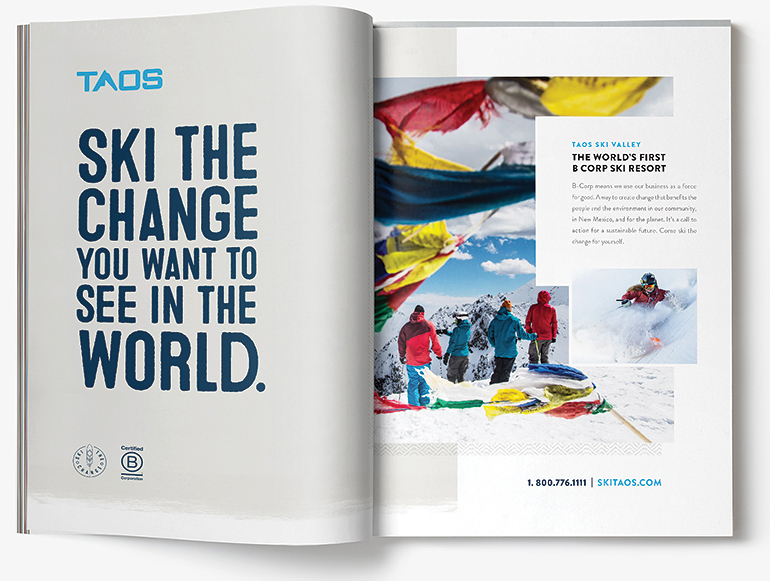 Taos print ad magazine spread.
Taos print ad magazine spread.
Taos CEO David Norden says, “We know that purpose-driven organizations outperform the competitive set on a regular basis. Aligning our brand messaging with our purpose has helped us in many ways, including staff recruitment, training, and engagement. Guests feel that the message resonates, too. More than anything, we believe in the idea of using business as a force for good.”
When to Get Emotive
It’s important to understand that emotional marketing works best if consumers already have some awareness of your brand. Consumers need to understand enough about the product to associate values and good feelings with it. Emotive marketing is the best fit when:
a) You are targeting consumers with moderate-to-high awareness and some existing affiliation with your brand; or
b) your product is well-known but largely indistinguishable from your competitors; or
c) you have a robust mid-funnel product marketing strategy already in place; or
d) you’re trying to reposition your brand.
Emotive marketing is not the best solution when you’re trying to increase brand understanding, which is different than brand resonance or relevance.
So, What Now?
The framework of the right person, at the right time, with the right message, through the right channel still applies here. We’re not throwing away any marketing fundamentals.
If you’ve identified that your brand could benefit from this relevance and resonance with your target audience, you can follow Sinek’s Golden Circle for your marketing content or campaign. Start by answering some simple questions:
1. Why? Why are you doing what you’re doing? Why are you in business? (i.e., what’s your purpose? The answer is not, “to make a profit.”)
2. How? How will this help your guests? For example: What problems are you solving for them? What challenges are you helping them overcome?
3. What? What are you offering? What are the features and benefits of your resort?
When you design your next landing page, your next call to action (CTA), or your next ad, remember to appeal to the human side in all of us. But remember to be true to your brand. It’s about the entire experience the brand gives its guests every time they connect—from the call center and reading content on your website, to talking to a ski instructor and getting a beer at après. It should be unique to your brand.
For example, the Jay Peak campaign wouldn’t work for any of our other resort clients. It’s true to Jay Peak and speaks to its unique brand values and leadership style.
Also, be specific. You’re not trying to communicate with everyone—just your buyer or ideal customer—so your marketing messages and content shouldn’t be a one-size-fits-all approach. Think about your target audience: What are their aspirations or motivations? What are some of their barriers to visit you? Write your copy to solve that person’s needs.
And, of course, don’t forget your call to action. If you don’t ask, you don’t get, so tell your guests what you want them to do next.





